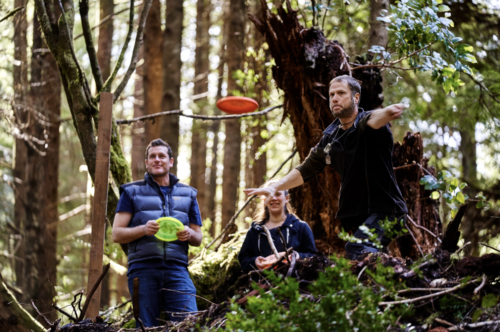Experience dramatic tidal swings safely from overlooks and beaches this winter.
King-tide season is just around the corner, bringing with it some pretty spectacular views for Oregon Coast visitors. Each day the tidal swings are especially dramatic, with the ocean tides running much higher up the beaches than usual, then receding so far back that they measure as what’s known as minus tides. Read on to learn more about why the Coast sees huge swings in high and low tides during this time, how to safely experience king tides, and how your photos can help scientists better understand the state of the ocean.
What Happens During a King-Tides Cycle?
The nonscientific term “king tides” simply refers to the highest tides of the year, which occur when the moon is new or full and at its perigee (closest to the earth), increasing the lunar gravitational pull. During such events, tides swell and sections of beaches that are normally exposed — even during normal high tides — can be completely submerged. While these tides are spectacular to see (from a safe distance), they do sometimes splash over sea walls and cause flooding and other damage.
King tides are always accompanied by their extreme opposite: minus tides. During minus-tide periods, the tides pull way back due to the same lunar effects, exposing parts of the shore that are usually submerged during less extreme tidal periods.

King Tides and Beach Safety
King tides are an undoubtedly impressive sight to see, but the volumes of water that these tidal events bring with them are best witnessed from afar, especially if a winter storm creates even more turbulent conditions. It’s unwise to walk on the beach during king-tide periods. Even if a beach isn’t officially closed due to safety or flood risks, it’s still best to keep your distance and view the waters from behind the guardrail of a coastal overlook instead.
Opportunities for viewing the tides abound up and down the Oregon Coast, from the cliffs at Shore Acres State Park to the headlands of the Cape Perpetua Scenic Area. For a particularly safe and comfortable experience, consider a night in an ocean-facing hotel — the Surfsand Resort in Cannon Beach or Lincoln City’s Pelican Shores Inn, or treat yourself to a stay at WildSpring Guest Habitat and see the ocean from a steaming hot tub.
If you absolutely must walk on the beach, you’re in luck. The minus tides are ideal for beach walks and beachcombing, provided you never turn your back to the ocean and always check the tide table before setting foot on the sand. You may see some amazing creatures or plants on the beach or in tide pools during minus tides.

How You Can Help Scientists Monitor Ocean Health
King tides provide scientists with important clues about the state of the ocean and help them make predictions about the impact of rising sea levels both on coastal communities and on the earth’s ecosystem. One way they do this is by examining images of the tides and their impact on shorelines and natural features. Enter the Oregon King Tides Project. The project’s goal is to help scientists, government officials and the general public understand the impact of rising sea levels as well as the impact of king tides on local communities. It’s run by the Oregon Coastal Management Program and CoastWatch, and they depend on citizen scientists to help.
That’s where you — and your iPhone — come in. Enter the project’s annual photo contest, which invites Oregon Coast visitors and residents to submit images of key areas of tidal impact. They might ask you to choose features like impeded beach access, cliff and bluff erosion, or the impact on infrastructure. But don’t wait until the king tides to take photos, as shots from the same location over time are also valuable, making it easy for scientists to analyze the direct impact of these events.
Want to contribute to the efforts? Keep an eye on the Oregon King Tides Project website for the themes for the 2025–26 contest.
When to Expect King Tides in Winter 2025-26
The projected dates for Oregon Coast king tides in the winter of 2025-26 are November 5-7, December 4-6, and January 1-4. For more tide information, consult the National Oceanic and Atmospheric Administration’s tide-predictions tool.
– By Margot Bigg / Photos by Jeremy Burke
– edited December 2025 OCVA



